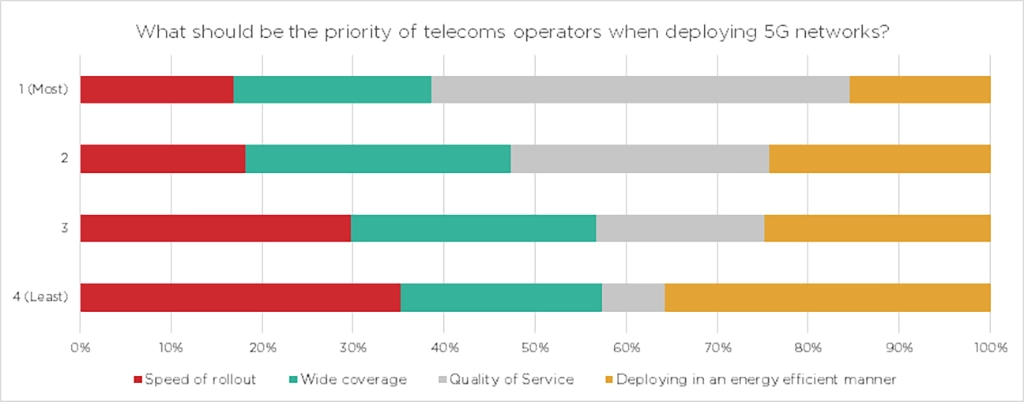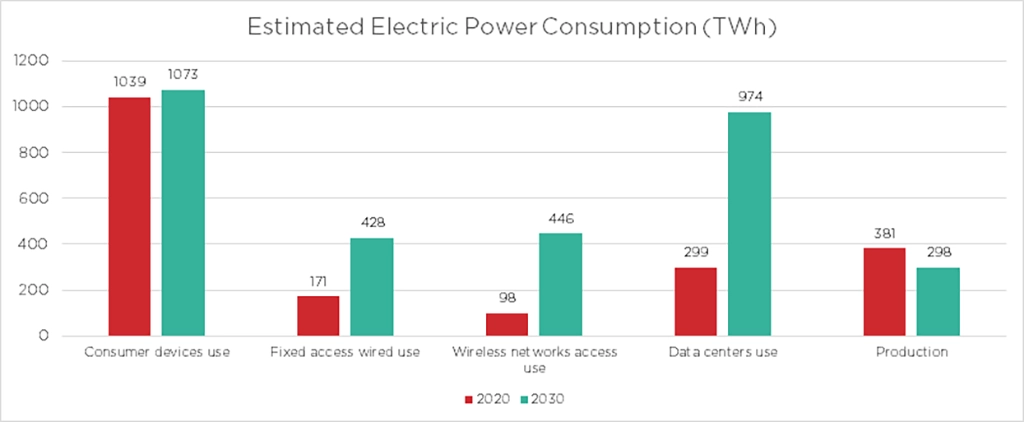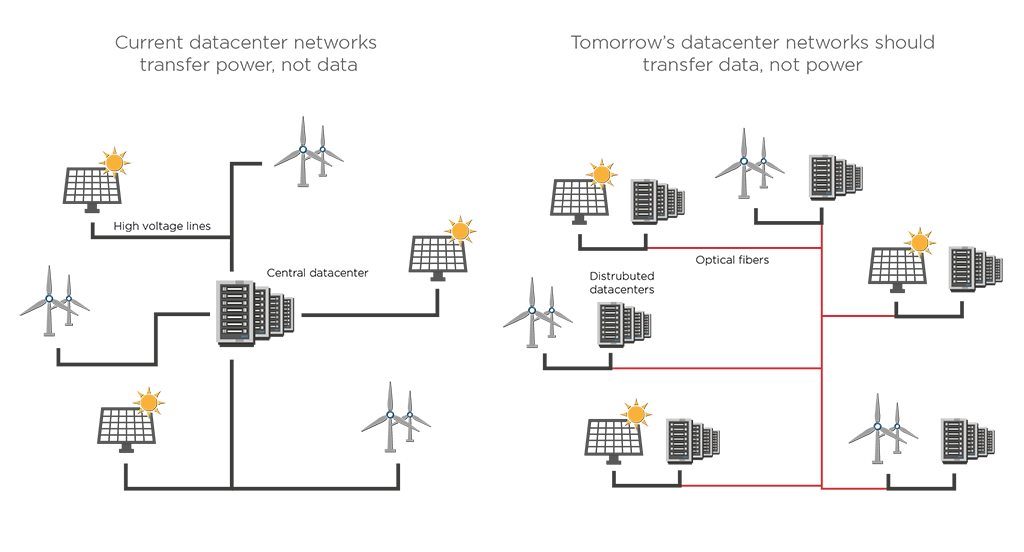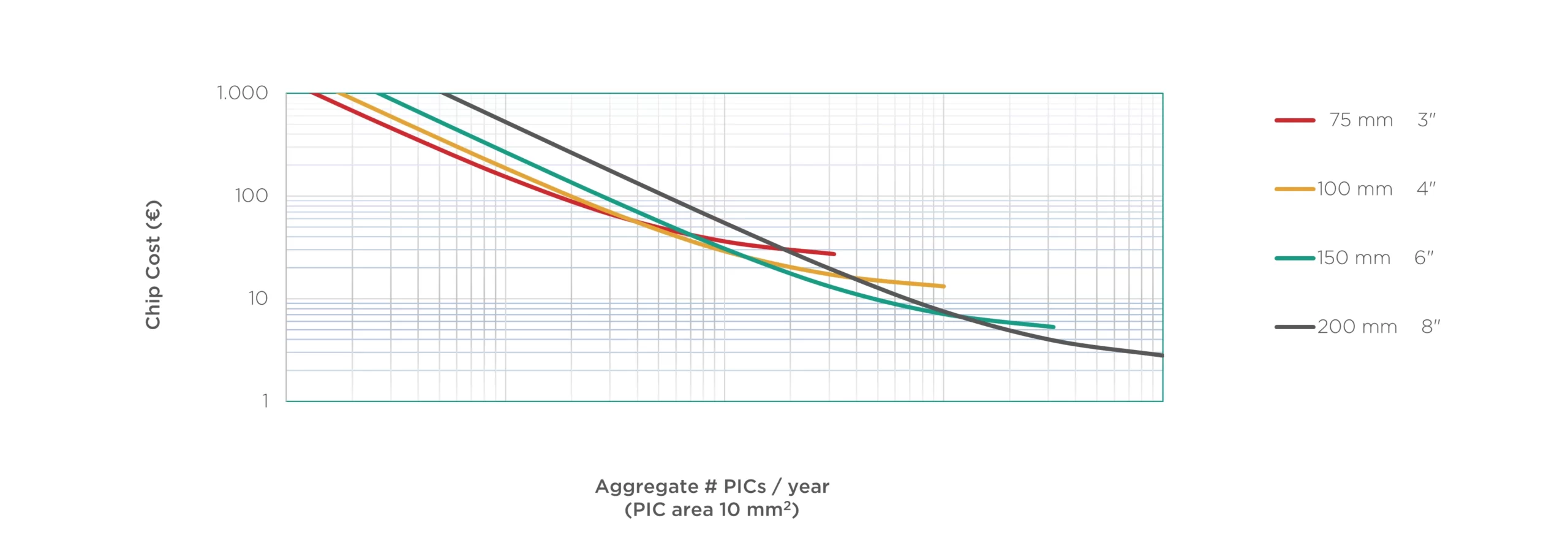Why Greener Transceivers are Profitable
Thanks to the incredible progress in energy-saving technologies (hyperscale datacenters, photonic and electronic integration), the exponential growth in data traffic for the next ten years will not lead to an exponential growth in ICT energy consumption. A 2020 study by Huawei Technologies estimates that from 2020 to 2030, global data traffic will grow 14 times while ICT energy consumption will just increase 1.5 times. Telecom operators, customers, employees, and investors are all paying more attention to sustainability.
A study commissioned by Vertiv surveyed 501 telecom enterprises worldwide, and 24% of them thought that energy efficiency should be their first priority when deploying 5G networks, while 16% saw it as their second priority. People are more likely to work for and buy products from companies with clear and ambitious sustainability goals. Investors and shareholders demand risk premiums from assets that underperform on climate goals, which often happens with fossil fuel companies. Such risk premiums could carry over to the telecom and datacom sectors. Sustainability is no longer just a matter of corporate social responsibility; it has real financial consequences.

However, there’s even more to the sustainability story. The telecom and datacom industries should become more sustainable not just because investors and customers like it, but also because it can lead to affordable ways to scale up capacity. After all, sustainable systems are efficient systems that are often smaller, more affordable, and require less energy spending. In this article, we will dive into one of an example of this trend by explaining how compact, fully-integrated optical transceivers can play an essential role in transitioning towards a greener and more affordable telecom infrastructure.
Telecom Equipment Dissipates Heat…and Money
Data centers and 5G networks might be hot commodities, but the infrastructure that enables them runs even hotter. Electronic equipment generates plenty of heat, and the more heat energy an electronic device dissipates, the more money and energy must be spent to cool it down. The Uptime Institute estimates that the average power usage effectiveness (PUE) ratio for data centers in 2020 is 1.58.
This number means that, on average, every 1 kWh required to power ICT equipment needs an additional 0.58 kWh for auxiliary equipment such as lighting and especially cooling. Datacenter PUE will decrease in the coming decade thanks to the emergence of hyperscale data centers, but the exponential increase of data traffic and 5G services also means that more data centers must be built too, especially on the network edges. For all the bad reputation that datacenters receive for their energy consumption, wireless transmission generates even more heat than wired links. While 5G standards are more energy-efficient per bit than 4G, the total power consumption will be much higher than 4G. Huawei expects that the maximum power consumption of one of their 5G base stations will be 68% higher than their 4G stations.
To make things worse, the use of higher frequency spectrum bands and new Internet-of-Things use cases requires the deployment of more base stations too. Prof. Earl McCune from TU Delft estimates that nine out of ten watts of electrical power in 5G systems turn into heat. This issue is why the Huawei also expects that the energy consumption of wireless access networks will increase even more quickly than that of data centers in the next ten years—more than quadrupling between 2020 and 2030.

These issues do not just affect the environment but also the bottom lines of communications companies. McKinsey reports that by the end of 2018, energy costs already represented 5% of operating expenditures for telecom operators. These costs will increase even further with the exponential growth of traffic and the deployment of 5G networks.
Compactness Makes Integrated Photonics Cool
Decreasing energy consumption and costs requires more efficient equipment, and a key to achieving this goal is to increase the use of photonics and miniaturization. Photonics has several properties that improve energy efficiency. Light transmitted over an optical fiber can carry more data faster and over longer distances than electric signals over wires, while dissipating less heat. Due to their longer reach, optical signals also save power compared to electrical signals by reducing the number of times the signal needs regeneration.
Photonics can also play a key role in rethinking the architecture of data centers. Photonics enables a more decentralized system of datacentres with branches in different geographical areas connected through high-speed optical fiber links to cope with the strain of data center clusters on power grids.
For example, data centers can relocate to areas where spare power capacity is available, preferably from nearby renewable energy sources. Efficiency can increase further by sending data to branches with spare capacity. The Dutch government has already proposed this kind of decentralization as part of their spatial strategy for data centers.

As we have explained in previous articles, miniaturization of telecom technology can also improve energy efficiency and affordability. For example, over the last decade coherent optical systems have been miniaturized from big, expensive line cards to small pluggables the size of a large USB stick. These compact transceivers with highly integrated optics and electronics have shorter interconnections, fewer losses, and more elements per chip area. These features all lead to a reduced power consumption over the last decade, as shown in the figure below.

Transceivers can decrease their energy consumption further by using an optical System-On-Chip (SoC). The SoC integrates all photonic functions on a single chip, including lasers and amplifiers. This full integration leads to simpler and more efficient interconnections between optical elements, which leads to lower losses and heat dissipation. Optical SoCs also allow coherent transceivers to have a similar reach to line card transponders for use cases up to 400G, so the industry does not have to choose between size and performance anymore.
Wafer Scale Processes Make Integrated Photonics Affordable
Previously, deploying coherent technology required investing in large and expensive transponder equipment on both sides of the optical link. The rise of integrated photonics has not only reduced the footprint and energy consumption of coherent transceivers but also their cost. The economics of scale principles that rule the semiconductor industry reduce the cost of optical SoCs and the transceivers that use them. SoCs minimize the footprint of the optics, allowing transceiver developers to fit more optics within a single wafer, which decreases the price of each individual optical system. As the graphic below shows, the more chips and wafers are produced, the lower the cost per chip becomes.

Integrating all optical components—including the laser—on a single chip shifts the complexity from the expensive assembly and packaging process to the more affordable and scalable semiconductor wafer process. For example, it’s much easier to combine optical components on a wafer at a high-volume than it is to align components from different chips together in the assembly process. This shift to wafer processes also helps drives down the cost of the device.
Takeaways
Pluggable transceivers with compact, highly-integrated optics are more energy efficient and therefore save money in network operational expenditures such as cooling. They can even lead to datacenter architectures that make the most out of the existing electricity and processing resources, allowing cloud providers to make the most of their big infrastructure investments.
By integrating all the optical components in a single SoC, more of them can fit on a single wafer and scale up to higher production volumes. Thanks to the economics of scale, higher volume production leads to lower sales prices, which reduces operators’ capital expenditures too. Due to all the reasons described above, it should now be clear why these greener pluggable transceivers will become a key factor in the successful and profitable deployment of coherent technology in future access networks.
